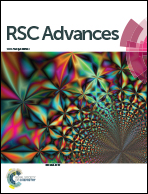Photoluminescent epoxy microspheres: preparation, surface functionalization via grafting polymerization and photophysical properties
Abstract
In this contribution, we reported the preparation of photoluminescent epoxy microspheres. First, diglycidyl ether of tetraphenylethene (DGETPE), a novel epoxy monomer bearing tetraphenylethene was synthesized and then it was incorporated into a commercial epoxy (viz. diglycidyl ether of bisphenol A) to obtain the epoxy microspheres with sizes of 1–3 μm via a phase-inverted reaction-induced phase separation approach. It was found that the epoxy microspheres were luminescent under UV light radiation. The surfaces of the photoluminescent epoxy microspheres were further functionalized with poly(N-vinyl pyrrolidone) (PVPy) with a grafting-from methodology via reversible addition–fragmentation chain transfer/macromolecular design via the interchange of xanthate (RAFT/MADIX) process. The PVPy-grafted epoxy microspheres can be well dispersed into aqueous solutions. The morphologies and photophysical properties of the epoxy microspheres were investigated by means of scanning electron microscopy, and UV-vis and fluorescence spectroscopy.


 Please wait while we load your content...
Please wait while we load your content...